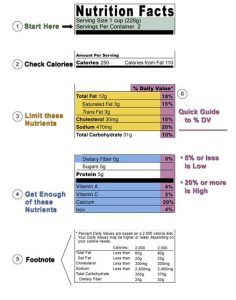One of the best ways to be mindful of exactly what you are eating is to become a label reader. Reading food labels help you make the best choices when grocery shopping.
The serving sizes used on the food label are standardized to help us compare like foods (cereal is in cups, crackers are listed as number of crackers). Be mindful of this amount, as one serving might not necessarily be the same as much you typically eat. Even products that seem like a single serving container may be two or more servings.
The Nutrition Facts label tells us how many calories are in each serving. We all have a calorie budget and we need to determine if a food fits into our daily calorie budget. The label above indicates that there are 250 calories per serving, which is one cup. If we ate 1 ½ cups of this food, we would get 250 + 125 calories for a total of 375 calories. Pay close attention to serving sizes as they are critical to managing calories and body weight.
Limit the nutrients highlighted in yellow, which are nutrients Americans typically eat in adequate amounts, or even too much. Type of fat is more important in determining a healthy diet than amount of fat. For example, the Mediterranean-style diet is rich in healthy fats and it is a healthy diet.
Tips for using the Nutrition Facts Panel:
- Serving size – pay attention to how many servings you eat and plan how they fit into your daily calorie budget.
- Calories – this tells you how many calories are in one serving.
- Trans fat – eliminate them completely. Even if it says “0g” on the label, check the ingredient list for hydrogenated or partially hydrogenated oil.
- Fiber – fiber fills you up and carries you to the next meal. It is recommended for women to have 25g per day and men to have 38g per day.
- Sugar – limit the amount of sugar in your diet. Be mindful of how much sugar is listed on the label and in the ingredients list.
- Ingredient list – the ingredient present in the largest amount by weight is listed first. When choosing a whole gain product, make sure “whole wheat” is listed first on the list. Even if the bread looks like wheat, it might not actually be whole wheat.
The Food and Drug Administration has announced upcoming changes to the Nutrition Facts label to make them easier to compare between foods. The most exciting feature is that the new label will break down sugars in to added and natural. This will help us easy see how much sugar has been added to the product and determine if it is a good choice for us. The label will also have updated serving size requirements and a refreshed design to better understand the label.
